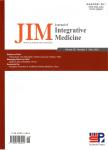Mechanisms underlying the vascular relaxation activities of Zingiber officinale var. rubrum in thoracic aorta of spontaneously hypertensive rats
Mechanisms underlying the vascular relaxation activities of Zingiber officinale var. rubrum in thoracic aorta of spontaneously hypertensive rats作者机构:Department of PhysiologySchool of Pharmaceutical SciencesUniversiti Sains Malaysia11800 MindenPenangMalaysia Department of PharmacologySchool of Pharmaceutical SciencesUniversiti Sains Malaysia11800 MindenPenangMalaysia Department of ChemistrySchool of Pharmaceutical SciencesUniversiti Sains Malaysia11800 MindenPenangMalaysia
出 版 物:《Journal of Integrative Medicine》 (结合医学学报(英文版))
年 卷 期:2020年第18卷第1期
页 面:46-58页
核心收录:
学科分类:1008[医学-中药学(可授医学、理学学位)] 1006[医学-中西医结合] 100602[医学-中西医结合临床] 10[医学]
基 金:supported by the Fundamental Research Grant Scheme,Ministry of Higher Education,Malaysia(203/PFARMASI/6711408) MyPhD(MyBrain programme),Ministry of Higher Education,Malaysia
主 题:Zingiber officinale var.rubrum Vasorelaxation Vasoconstriction Aortic rings Herbal medicine
摘 要:Objective: To evaluate vasorelaxant and vasoconstriction effects of Zingiber officinale var. rubrum(ZOVR)on live rats and isolated aortic rings of spontaneously hypertensive rats(SHRs).Methods: Extracts of ZOVR were subjected to in-vivo antihypertensive screening using noninvasive blood pressures in SHRs. The most potent extract, ZOVR petroleum ether extract(ZOP) was then fractionated using n-hexane, chloroform and water. Isolated thoracic aortic rings were harvested and subjected to vascular relaxation studies of n-hexane fraction of ZOP(HFZOP) with incubation of different antagonists such as Nω-nitro-L-arginine methyl ester(L-NAME, 10 μmol/L), indomethacin(10 μmol/L), methylene blue(10 μmol/L), atropine(1 μmol/L), glibenclamide(10 μmol/L), prazosin(0.01 μmol/L), and propranolol(1 μmol/L).Results: During the screening of various ZOVR extracts, ZOP produced the most reduction in blood pressures of SHRs and so did HFZOP. HFZOP significantly decreased phenylephrine-induced contraction and enhanced acetylcholine-induced relaxation. L-NAME, indomethacin, methylene blue, atropine, and glibenclamide significantly potentiated the vasorelaxant effects of HFZOP. Propranolol and prazosin did not alter the vasorelaxant effects of HFZOP. HFZOP significantly suppressed the Ca2+-dependent contraction and influenced the ratio of the responses to phenylephrine in Ca2+-free ***: This study demonstrates that ZOP may exert an antihypertensive effect in the SHR model. Its possible vascular relaxation mechanisms involve nitric oxide and prostacyclin release, activation of cGMP-KATP channels, stimulation of muscarinic receptors, and transmembrane calcium channel or Ca2+release from intracellular stores. Possible active compounds that contribute to the vasorelaxant effects are 6-gingerol, 8-gingerol and 6-shogaol.



